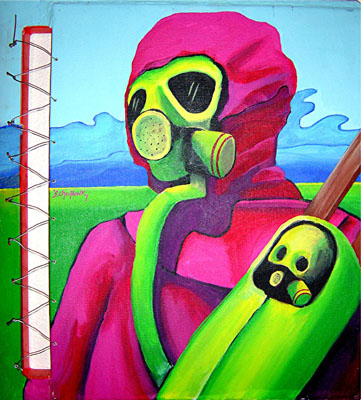Artists remember toxic waste
Taking Control: Opportunities for and Impediments to the Use of Socio-Cultural Controls for Long-Term Stewardship of U.S. Department of Energy Legacy Waste SitesThe Institute brought together 25 indigenous and other storytellers, songwriters, poets, and dancers with historians and other representatives from a variety of tribal and disadvantaged communities in proximity to DOE legacy waste sites, along with policy makers from various public agencies with an interest in addressing environmental problems through the humanities. Roundtable participants were briefed on the types and hazards of persistent contamination from the DOE legacy sites, future hazards for human health and the environment, and the limitations of standard institutional controls. In facilitated discussions, roundtable participants set out the potential benefits of and strategies for encouraging creative/historical discourses that carry basic information about the histories of the sites, and risks of environmental contamination. Roundtable participants discussed how historical, cultural, and spiritual attachments to place are reflected in stories, songs, poems, and histories and how such discourses might also transmit information about environmental contamination that is crucial for safeguarding future generations.
The roundtable discussions examined ways long term stewardship of DOE legacy waste sites can be enhanced through various methods of storytelling. It brought together artists and community representatives so artists can understand the broad universe of interests, including the spiritual, cultural and historical interests the people have in these landscapes. Conversely, it demonstrated to the community representatives that there are other means by which they can protect their long term interests. The roundtable discussions also sought to inform federal land managers about other mechanisms of long term stewardship beyond the conventional methods of institutional control.See especially
Appendix C: “Yucca Mountain” A Demonstration Comic Book.



1 comment:
I agree with your basic point. The title is too long and so are the sentences in the text. Tip to report writers: Avoid using more than 20 words per sentence.
The report didn't use much jargon, but it did use too many big words. The author could've recast the first sentence of the excerpt as
The Institute brought together three groups:
* Writers, artists, and other storytellers with an indigenous focus;
* Historians and other representatives from at-risk communities near DOE legacy waste sites;
* Policy makers interested in addressing environmental problems through the humanities.
Isn't that a lot easier to read? Sure it is. I've reduced the sentence from 51 to 40 words and, more important, grouped the items into easily scanned bullet points.
If anyone else needs help streamlining and improving your writing, give me a call. That's what I do for a living.
Post a Comment